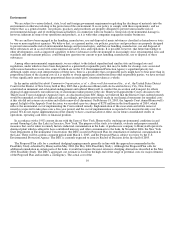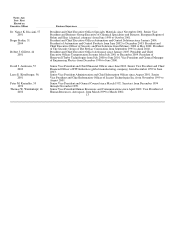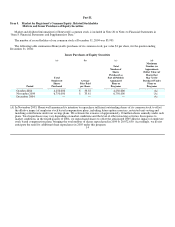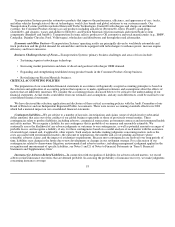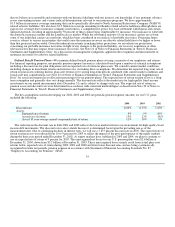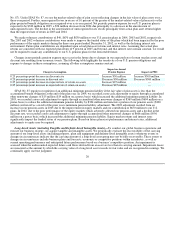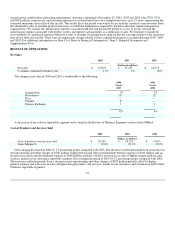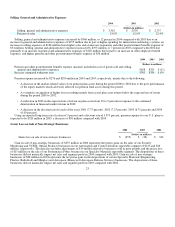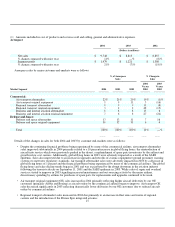Honeywell 2004 Annual Report Download - page 32
Download and view the complete annual report
Please find page 32 of the 2004 Honeywell annual report below. You can navigate through the pages in the report by either clicking on the pages listed below, or by using the keyword search tool below to find specific information within the annual report.
that we believe are reasonable and consistent with our historical dealings with our insurers, our knowledge of any pertinent solvency
issues surrounding insurers and various judicial determinations relevant to our insurance programs. We have approximately
$1.3 billion in insurance coverage remaining that can be specifically allocated to North American Refractories Company (NARCO)
related asbestos liabilities. We also have $1.9 billion in coverage remaining for Bendix related asbestos liabilities although there are
gaps in our coverage due to insurance company insolvencies, a comprehensive policy buy-back settlement with Equitas and certain
uninsured periods, resulting in approximately 50 percent of these claims being reimbursable by insurance. Our insurance is with both
the domestic insurance market and the London excess market. While the substantial majority of our insurance carriers are solvent,
some of our individual carriers are insolvent, which has been considered in our analysis of probable recoveries. Projecting future
events is subject to various uncertainties that could cause the insurance recovery on asbestos related liabilities to be higher or lower
than that projected and recorded. Given the inherent uncertainty in making future projections, we reevaluate our projections
concerning our probable insurance recoveries in light of any changes to the projected liability, our recovery experience or other
relevant factors that may impact future insurance recoveries. See Note 21 of Notes to Financial Statements in “Item 8. Financial
Statements and Supplementary Data” for a discussion of management's judgments applied in the recognition and measurement of
insurance recoveries for asbestos related liabilities.
Defined Benefit Pension Plans—We maintain defined benefit pension plans covering a majority of our employees and retirees.
For financial reporting purposes, net periodic pension expense (income) is calculated based upon a number of actuarial assumptions
including a discount rate for plan obligations and an expected rate of return on plan assets. We consider current market conditions,
including changes in investment returns and interest rates, in making these assumptions. We determine the expected long-term rate of
return on plan assets utilizing historic plan asset returns over varying long-term periods combined with current market conditions and
broad asset mix considerations (see Note 22 of Notes to Financial Statements in “Item 8. Financial Statements and Supplementary
Data” for actual and targeted asset allocation percentages for our pension plans). The expected rate of return on plan assets is a long-
term assumption and generally does not change annually. The discount rate reflects the market rate for high-quality fixed-income
investments on our annual measurement date (December 31) and is subject to change each year. The expected rate of return on
pension assets and discount rate were determined in accordance with consistent methodologies as described in Note 22 of Notes to
Financial Statements in “Item 8. Financial Statements and Supplementary Data”.
The key assumptions used in developing our 2004, 2003 and 2002 net periodic pension expense (income) for our U.S. plans
included the following:
2004 2003 2002
Discount rate 6.00% 6.75% 7.25%
Assets:
Expected rate of return 9% 9% 10%
Actual rate of return 13% 23% (8)%
Actual 10 year average annual compounded rate of return 11% 10% 9%
The reduction in the discount rate in both 2004 and 2003 reflects the lower market interest rate environment for high-quality fixed
income debt instruments. The discount rate is also volatile because it is determined based upon the prevailing rate as of the
measurement date. Due to continuing declines in interest rates, we will use a 5.875 percent discount rate in 2005. The expected rate of
return on plan assets was reduced from 10 to 9 percent for 2003 to reflect the impact of the poor performance of the equity markets
during the three year period ended December 31, 2002. As equity markets have stabilized in 2003 and 2004, we plan to continue to
use an expected rate of return of 9 percent for 2005. The unrecognized net losses for our U.S. pension plans were $2.6 billion at
December 31, 2004, down from $3.2 billion at December 31, 2003. These unrecognized losses mainly result from actual plan asset
returns below expected rates of return during 2002, 2001 and 2000 and from lower discount rates and are being systematically
recognized in future net periodic pension expense in accordance with Statement of Financial Accounting Standards No. 87,
“Employers Accounting for Pensions” (SFAS
19



